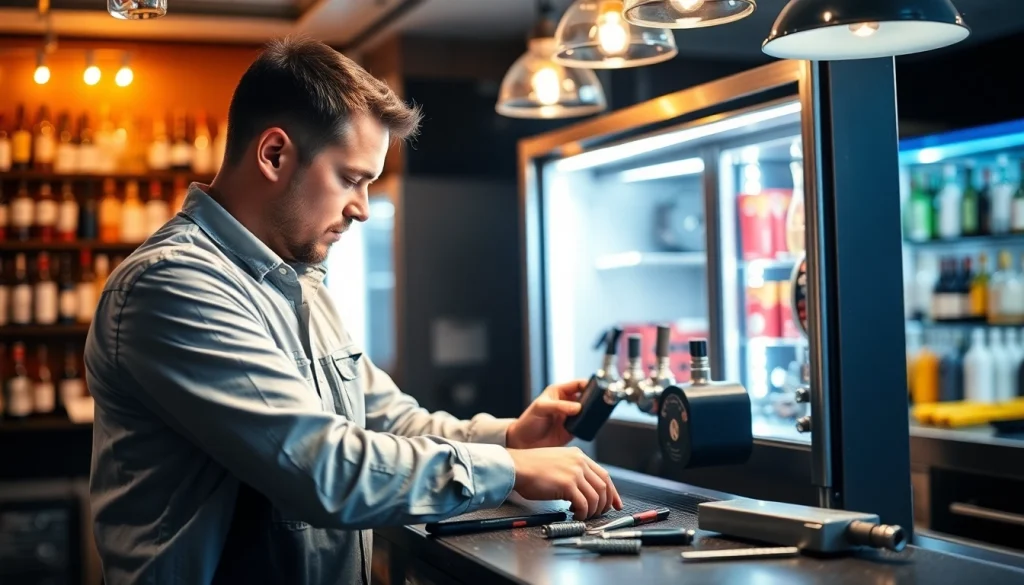Understanding Bar Refrigeration Systems
Bar refrigeration systems are essential for establishments that serve cold beverages and maintain perishable items. These systems not only keep drinks at the right temperature but also ensure the preservation of ingredients used in different recipes. Understanding how bar refrigeration works, the types of equipment involved, and the common issues that arise can help bar owners maintain efficient operations. Whether you’re in need of bar refrigeration repair or just seeking to understand your systems better, this guide provides a comprehensive overview.
Types of Bar Refrigeration Equipment
Bar refrigeration equipment varies based on the specific needs of different establishments. Here’s a look at some of the most common types:
- Refrigerated Back Bar Coolers: These units keep bottles chilled and are designed for easy access. They often feature glass doors for visibility, which can enhance the customer experience by showcasing the drink options.
- Under-Counter Refrigerators: Compact and efficient, these units are often placed directly under work surfaces to minimize the distance staff must travel to retrieve cold items. They are perfect for ensuring quick service.
- Ice Makers: These are critical for any bar operation. Having a reliable ice maker guarantees that drinks can be served at optimal temperatures.
- Beer Coolers: Specialized units for storing kegs and cans, beer coolers are designed to maintain lower temperatures that prevent positive yeast activity, ensuring freshness.
- Walk-in Refrigerators: Larger establishments might require walk-in units to store stock for extended periods. These provide ample space for different types of beverages and perishables.
How Bar Refrigeration Works
The principles of bar refrigeration are based on thermodynamics and involve changing the state of refrigerants within a system. Here are the key components:
- Evaporator Coils: Located inside the refrigerator, these coils absorb heat from the interior, causing the refrigerant inside to evaporate and cool the air.
- Compressor: This component compresses the vaporized refrigerant and moves it to the condenser where it cools down. This process is vital for maintaining the refrigeration cycle.
- Condenser Coils: Positioned outside the unit, the condenser expels heat that was absorbed by the refrigerant, returning it to a liquid state.
- Expansion Valve: This part regulates the flow of refrigerant into the evaporator, allowing it to cycle effectively and maintain consistent temperatures.
Common Issues in Bar Refrigeration
Bar refrigeration systems can encounter a variety of issues that, if not addressed, may lead to costly repairs or loss of inventory. Here are some common problems:
- Temperature Fluctuations: This can arise from a malfunctioning thermostat or faulty compressor, leading to drinks cooling improperly and ruining food stocks.
- Leaking Refrigerant: If refrigerant levels drop due to leaks, efficiency declines drastically. This not only impacts temperature regulation but can also result in increased energy bills.
- Compressor Failures: The most crucial component of the refrigeration cycle, if the compressor fails, the entire system will stop working, necessitating immediate repair.
- Dirty Condenser Coils: When condenser coils are coated with dust and grime, their ability to expel heat is compromised, often leading to overheating issues.
- Ice Buildup: This can occur due to humidity levels being too high or if the door seals are damaged, restricting airflow and potentially leading to malfunctions.
The Importance of Timely Bar Refrigeration Repair
Considering the role that refrigeration systems play in maintaining inventory and service quality, timely repairs are essential. A problem left unchecked can escalate into a crisis, affecting both operations and revenue.
Potential Risks of Neglecting Repairs
Failing to address refrigeration problems can lead to numerous operational risks:
- Inventory Loss: Malfunctioning refrigeration can cause perishable goods to spoil, resulting in substantial financial losses. For bars, this includes the cost of drinks and ingredients.
- Health Violations: The failure to keep food and drink at safe temperatures can lead to health code violations, resulting in fines or closure from health inspections.
- Decreased Customer Satisfaction: Poor service stemming from warm drinks or unavailable items can deter customers, damaging your establishment’s reputation.
- Increased Repair Costs: Ignoring minor issues can lead to major breakdowns that require more intensive repairs, resulting in unexpected costs.
Benefits of Prompt Maintenance
Engaging in timely repairs and maintenance presents several benefits that positively impact overall operations:
- Extended Equipment Lifespan: Regular maintenance can prolong the life of refrigeration systems, maximizing your investment and reducing the need for frequent replacements.
- Energy Efficiency: Well-maintained units operate more efficiently, which can lower energy bills and contribute to a greener business.
- Improved Safety: Regular checks ensure that potential hazards, like refrigerant leaks, are identified and managed promptly, safeguarding your employees and patrons.
- Enhanced Productivity: Reliable refrigeration allows staff to function efficiently without the worry of equipment failures interfering with service.
Cost Implications of Delayed Repairs
Evaluating the costs associated with delayed repairs can be a wake-up call for many bar owners:
- Emergency Repair Costs: Sudden breakdowns often require urgent repairs, which can be significantly more expensive than planned maintenance or repairs.
- Loss of Business: Even a short duration of downtime can lead to lost sales, especially during peak hours.
- Higher Utility Bills: A malfunctioning refrigeration system often works harder to maintain temperatures, resulting in escalated energy expenses.
Identifying Signs You Need Bar Refrigeration Repair
Being proactive about maintenance means recognizing signs that your bar refrigeration system may need repairs.
Common Symptoms of Malfunctioning Equipment
Look out for these warning signs that can indicate issues within refrigeration systems:
- Unexpected Temperature Changes: Consistent temperatures that suddenly rise can signal issues with the compressor or evaporator.
- Unusual Noises: Loud noises or clicking sounds often indicate mechanical failures within the compressor or fans.
- Water Leaks: Water pooling around the unit suggests either a blocked drain line or an internal leak that needs immediate attention.
- Frequent Cycling On and Off: This can be a sign of a thermostat malfunction or compressor issues, both of which need assessment.
- Foul Odors: Unpleasant smells can indicate spoilage inside the refrigerator or issues with the drainage system.
How to Monitor Performance Regularly
Regular monitoring is crucial for timely identification of issues:
- Temperature Checks: Use thermometers to verify that the temperatures are within the recommended range for beverages and perishables.
- Visual Inspections: Regularly inspect for any signs of leaks, frost buildup, or dirty coils.
- Listening for Sounds: Be attentive to any unusual sounds that could indicate mechanical issues.
- Maintaining Cleanliness: Ensure that the area around the refrigeration system is clean and that filters and coils are regularly serviced.
When to Call a Professional
It’s essential to know when to involve an expert:
- Persistent Problems: If issues recur after you have attempted to fix them, professional help is necessary.
- Complex Repairs: Any mechanical issues with the compressor or refrigerant leaks should always be handled by trained technicians.
- Out of Warranty Services: For systems still under warranty, consult the manufacturer or authorized service provider for repairs to ensure compliance with warranty conditions.
Finding the Right Bar Refrigeration Repair Service
When repair needs arise, selecting the right service provider can be crucial to ensuring efficient and effective solutions.
Key Qualities to Look For in a Technician
Here are some factors to consider when choosing a refrigeration technician:
- Certification: Ensure technicians are certified by recognized bodies, indicating they have received the appropriate training.
- Experience: Look for service providers who specialize in commercial bar refrigeration with extensive experience.
- References and Reviews: Check reviews and ask for references from past clients to gauge the quality of service.
- Reliability: Choose a technician known for punctuality and efficiency in service delivery.
Questions to Ask Before Hiring
Interview potential service providers to ensure they meet your needs:
- What experience do you have with bar refrigeration systems?
- Are you familiar with the specific brand of equipment we use?
- What is your response time for emergency services?
- Can you provide a written estimate before starting the repairs?
- Do you offer any warranties on your repairs and services?
Comparing Local Services Effectively
When evaluating local repair services, focus on the following:
- Service Coverage: Ensure they operate in your area and can provide timely service.
- Services Offered: Review the list of services to ensure they cover the specific repairs you need.
- Cost Comparison: Don’t just look for the cheapest option; consider the value offered in terms of quality and service level.
Preventative Maintenance for Bar Refrigeration
Implementing a scheduled maintenance routine can save considerable costs and extend the life of your refrigeration equipment.
Essential Maintenance Routines
Here are some fundamental maintenance tasks:
- Cleansing the Condenser Coils: Every six months, ensure the coils are cleaned to promote better cooling efficiency.
- Check Doors and Seals: Regularly inspect door seals for damages, as faulty seals can lead to energy loss and temperature inconsistencies.
- Monitor Refrigerant Levels: It’s crucial to keep refrigerant levels checked and topped off as necessary.
- Test Alarms and Controls: Ensure that the temperature controls and alarms are functioning to prevent future breakdowns.
Scheduling Regular Service Checks
Establish a routine to minimize potential failures:
- Monthly Employee Checks: Staff should be trained to physically inspect and report any anomalies in the system.
- Quarterly Professional Inspections: Schedule a professional service every three months for a comprehensive system checkup.
- Annual Overhaul: An in-depth review should be conducted annually to preemptively address any emerging issues.
Investing in Long-term Equipment Care
Investing in preventive maintenance just makes good financial sense:
- Cost Savings on Repairs: Paying for regular check-ups is generally significantly less than unexpected breakdown costs.
- Increased System Reliability: A well-maintained system operates more efficiently, which reduces energy costs and improves service.
- Better Return on Investment: Extending the lifespan of your refrigeration units means getting the most out of your initial investment.



